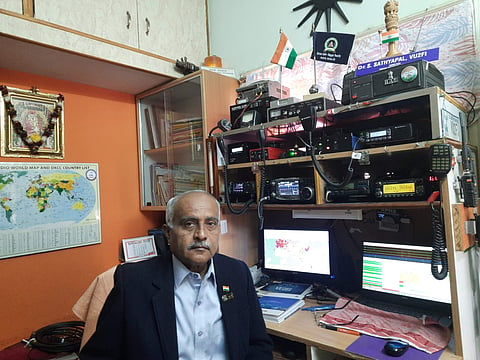

During disasters like earthquakes or floods, the first thing that goes kaput is the power. Mobile networks tumble next. Cut off from our hyper-connected world, you'd think that there's no way to communicate till your cell phones comes back to life, right?
Dead wrong.
Ham radios have existed as a mode of communication for decades. And the humble ham radio and its amateur operators have played a part during the pandemic too. The credit for pruning the ham radio culture in Bengaluru goes to Dr S Sathyapal, whose call sign is VU2FI. An avid ham radio operator who has trained thousands of youngsters to operate the device and the Q codes used to communicate, he is also the moving force behind the Indian Institute of Hams (IIH).
In April 2020, when the COVID-19 cases were rising, Dr S Sathyapal got a call from a bureaucrat to set up a ham radio station in the CM's war room, which he rushed and got done. "We started establishing contact with operators across the country on a defined frequency. We would help people from Karnataka if they were stuck in different states or had some issue related to COVID-19. For instance, once there was a KSRTC bus returning from Gujarat with a team of doctors. They weren't able to find food as all the hotels were closed. We alerted the Pune network to deliver water and food packets to them. I will not say that we played a major role in handling the COVID situation but it was like a drop of water in a ocean," explains Sathyapal happily.
This year too, the operators haven't remained idle. As soon as they got a call from the government, they established a ham radio station at one of the command centres in Bengaluru. "The main idea to establish a radio station in the command centre was to assist the task force and see that people don't stand in queues or suffer for a long time to perform last rites. We would monitor 16 crematoriums using nearly 30 ham radio operators, who lived there and would relay info," explains Sathyapal.
Dr Sathyapal's interest in ham radios goes back decades, "Right from my childhood, I was interested in wireless communication. Soon after completing my doctorate in Communication Management from The Indian Institute of Business Management and Studies, I applied for Ham Radio training. I passed my exams and got qualified to be an Amateur Radio Operator. In 1993, I got my license from the Ministry of Communication and Broadcasting."
Fancy some ham in Bengaluru?
But his love for radio comms is such that he decided to start an institute to train people. Started with RJ Marcus, a veteran ham operator who is popularly known as the Indian Marconi, IIH has grown over the years. "We started promoting ham radio through several programmes at schools, colleges and institutes. The reason behind establishing an institute in 1993 was because there was very little awareness about ham radio among Indians. Now, we have more radio operators in India than in Argentina. However, a lot of work needs to be done in this field."
Training thousands of students
So how many batches undergo the radio training every year? Sathyapal explains, "We conduct training for four batches because the Ministry of Communication and Broadcasting conducts an exam four times a year. Apart from that, we go to engineering institutions and other colleges to bring students and train them in some of these batches. However, owing to the pandemic we conduct classes online. But the number of people taking up ham radio training hasn't reduced. Since early 2020, we have trained around 600 people in radio operation."
But this doesn't mean that everybody will pass the exam and qualify to become an amateur radio operator. "For instance, if 100 people apply for the exam, then only 70 people may pass it. And among these 70 people, all of them might not even have a ham station at home. While some of them can afford to, others might not. Similarly, all the people who pass this exam might not like to get involved in disaster management. Some might use it only for recreation or to connect with people across the globe."
Sathyapal picks people with a social dint of mind and puts them under the umbrella of the Ham Action Force Group. "We train such people on the field by conducting mock drills and help them understand the process. We have three HAM radio kits ready in the master control room. Even if the person doesn't have a kit but knows to operate then we provide these kits during disasters," explains Dr Sathyapal.
Teaching them morse code
Besides this, IIH also trains children in Morse code, which is universally still used as a form of urgent transmission. "This year is the first time that we have taken the Morse code training online. Our batch of 2021 has 60+ students across India - the youngest being a Class VI student," he says.
Does it work for children, we wonder? "The level of concentration and grasping power of a child increases when they are trained in Morse code. I am training my six-year-old granddaughter who has already learnt 16 alphabets through Morse code," says Dr Sathyapal who is happy about taking classes online despite several technological challenges.
Reach Out: indianhams.com
